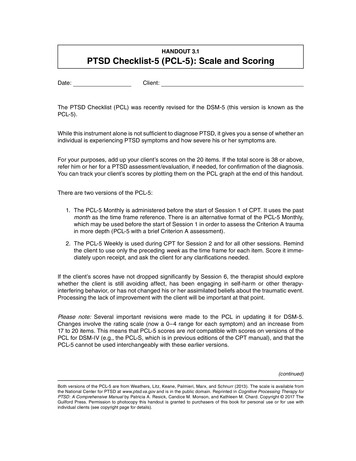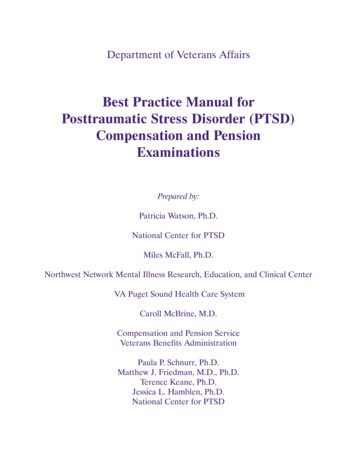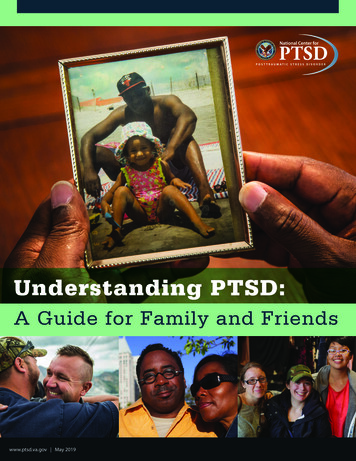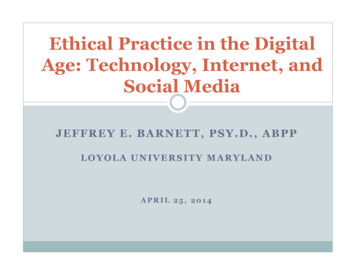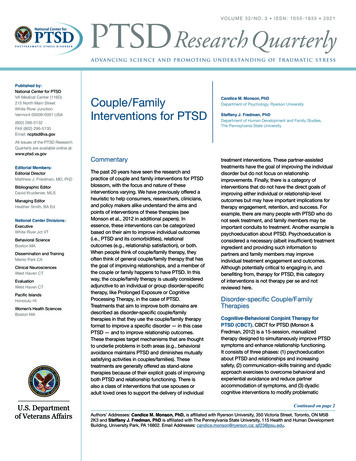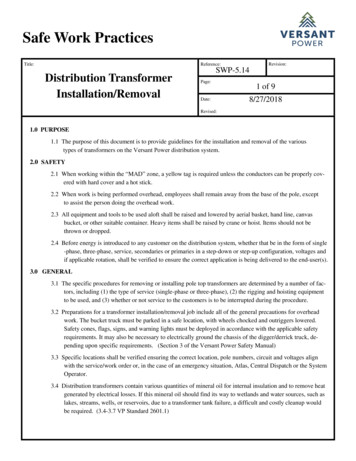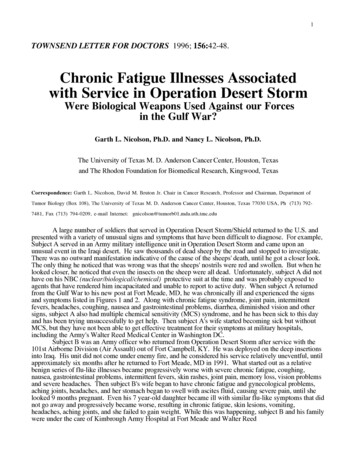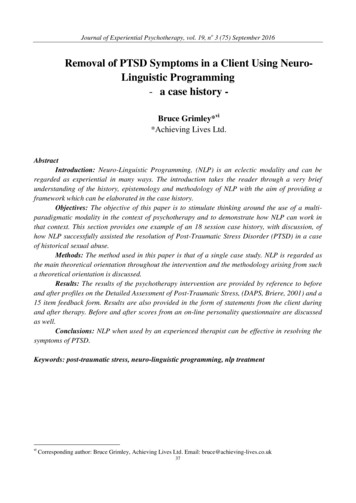
Transcription
Journal of Experiential Psychotherapy, vol. 19, no 3 (75) September 2016Removal of PTSD Symptoms in a Client Using NeuroLinguistic Programming- a case history Bruce Grimley*vi*Achieving Lives Ltd.AbstractIntroduction: Neuro-Linguistic Programming, (NLP) is an eclectic modality and can beregarded as experiential in many ways. The introduction takes the reader through a very briefunderstanding of the history, epistemology and methodology of NLP with the aim of providing aframework which can be elaborated in the case history.Objectives: The objective of this paper is to stimulate thinking around the use of a multiparadigmatic modality in the context of psychotherapy and to demonstrate how NLP can work inthat context. This section provides one example of an 18 session case history, with discussion, ofhow NLP successfully assisted the resolution of Post-Traumatic Stress Disorder (PTSD) in a caseof historical sexual abuse.Methods: The method used in this paper is that of a single case study. NLP is regarded asthe main theoretical orientation throughout the intervention and the methodology arising from sucha theoretical orientation is discussed.Results: The results of the psychotherapy intervention are provided by reference to beforeand after profiles on the Detailed Assessment of Post-Traumatic Stress, (DAPS, Briere, 2001) and a15 item feedback form. Results are also provided in the form of statements from the client duringand after therapy. Before and after scores from an on-line personality questionnaire are discussedas well.Conclusions: NLP when used by an experienced therapist can be effective in resolving thesymptoms of PTSD.Keywords: post-traumatic stress, neuro-linguistic programming, nlp treatmentviCorresponding author: Bruce Grimley, Achieving Lives Ltd. Email: bruce@achieving-lives.co.uk37
Journal of Experiential Psychotherapy, vol. 19, no 3 (75) September 2016we have of its benefits.” (Sturt, 2012). However key tounderstanding NLP is an appreciation of the belief thatour experience has a stable structure. This appreciationowes much to the syntactically driven paradigm of theday in linguistics, Transformational Grammar, (TG).John Grinder, a Co-Founder of NLP says: “The singlemost pervasive influence in NLP is the paradigm thatwas current in linguistics at the time of the creation ofNLP” (Bostic St Clair, & Grinder, 2001, p66)Just as in each alphabet around the world thereare a limited number of letters it is also the case thatthose letters can be arranged to create an almostunlimited set of meanings when they are organisedsyntactically and interpreted through lexical meaning,semantics and pragmatics. The parallel within NLP isthat we also, as experiencing individuals, have alimited sensory scope in our 3 major senses, Visual,Auditory and Kinaesthetic, (VAK) yet through variousorganising processes we create highly individualmental representations, carving up the external worldin an idiosyncratic way resulting in a personal patternof behaviour and language in various contexts as aresult of experiencing the world through theseindividual patterns. Key to NLP is an appreciation thatpeople act as a result of the relationship with theirpatterning and not as a result of a relationship with theterritory of objective world. It has been argued that TGrelies too much on syntax and not enough on thegenerative meaning making capacity of semantics andphonology, (Jackendoff, 2002), however other aspectsof NLP acknowledge and recognise the individualscapacity to generate meaning in non-syntactical waysthrough other non-verbal patterns which have beenmodeled from exemplars, one example being that ofanchoring, or in psychological terms classicalconditioning. Within NLP there are therefore 2 levelsof information processing sensory (F1) and thenlinguistic (F2) often it is the confusion between theselevels which leads to a lack of ecology in a person’slife and the reason they find themselves in therapy.Continuing to demonstrate the influence ofTG on NLP Bostic St Clair and Grinder, (2001), pointout that the meaning making characteristics of syntaxare implicit. A native speaker of English for instanceneeds little formal education to know the words “Twohouses” is a valid linguistic representation yet “Twomouses” is not, and should be “Two mice”. In manysimilar ways individuals may intuitively “know”something is not right for them in a particular context,however formally and at the level of language theycannot represent what is “not right” and consequentlystruggle to move forwards in an intelligent way. BosticI. IntroductionThe rather scientific name Neuro-LinguisticProgramming, (NLP), has many stories surrounding it.One version tells us it was a name made up on the spotwhen Richard Bandler, one of the Co-Founders, wasstopped by a police officer and asked what he did,(Brown, 2007, p. 173). Another story is that NLP wascoined by Bandler and Grinder in an intentionallymischievous way, possibly poking fun at its quasiacademic status (Tosey & Mathison, 2009, p. 12).Whatever the truth behind the name, what is beyonddispute is NLP, despite predictions by some academicsthat it would die out within a decade because of its lackof scientific rigour and it’s fad / cult like status, (Elich,Thompson, & Miller, 1985), is still very active andused in many domains,Heap in 2008 summarises the current andpossibly future trajectory of NLP from a psychologicalperspective when he says:“I believe that the following impressions arealso likely to be reliable.1. NLP continues to make no impact onmainstream academic psychology2. NLP has made only limited impact onmainstream psychotherapy and counselling3. NLP remains influential amongst privatepsychotherapists, including hypnotherapists, to theextent that they claim to be trained in NLP and ‘useNLP’ in their work.4. NLP training courses abound and NLP nowseems to be most influential in management training,lifestyle coaching, and so on. Particularly withreference to this, the term ‘growth industry’ appears tobe apposite.” (Heap, 2008, p. 7)However from the NLP perspective somepractitioners fight against this perceived pejorativeforecast and point to such academic volumes as mming, (Wake, Gray & Bourke., 2013) andpapers such as “Effects of Neuro-LinguisticPsychotherapy on psychological difficulties andperceived quality of life” (Stipancic, Renner, Schutz, &Dond., 2010). These academic contributions howeverseem to be very much the exception which proves therule and often are to be found in the psychotherapy andcounselling sectors.II. What is NLP?There are as many definitions of NLP as thereare NLP practitioners around the world. Professor Sturtmakes the telling point; “the very fact that there is noagreed definition of NLP indicates how little evidence38
Journal of Experiential Psychotherapy, vol. 19, no 3 (75) September 2016St Clair and Grinder (2001) say:“These intuitions have a stability andconsistency across individuals differing widely in allrespects except that they are fluent speakers of thelanguage in question. Such a characteristic makes thisset of intuitions ideal as the basis for modeling-for thedevelopment of explicit representations” (Bostic StClair & Grinder 2001, p73).Even though the stability of the intuitionscited above refers to language, it would be the mootclaim of NLP practitioners that just as there is structureto language there is also a structure to non-verbalexperience and through the creation of NLP designvariables we now have a language to map such implicitexperience. The first NLP model, or explicitrepresentation was the “Meta Model” and is formallylaid out in book form; The Structure of Magic,(Bandler & Grinder, 1975). This model primarily wasthe result of Bandler researching video tapes andreading transcripts of the work of Fritz Perls andobserving the work of Virginia Satir and then sharingthe skill he developed at University.After asking Associate Professor John Grinderto observe him running his Gestalt workshops at theUniversity of Santa Cruz with Frank Pucelik, Grindernoticed that there already was a formal linguisticrepresentation which the emerging model could maponto and that model was TG.Along with the Meta Model which is alinguistic model based on TG and the Milton modelwhich is often referred to as the reverse of the MetaModel, being based on the modelling of MiltonErickson, it is also the non-verbal design variableswhich make up much of the current NLP practitionercurriculum. These design variables offer linguisticallya representation of what is implicit structurally withinhuman phenomenology and thus provide individualswith the capacity to make meaningful alterations at anunconscious level which changes their experience.They were arrived at inductively during the modelingprocess as Bandler and Grinder observed and imitatedtheir subjects. Many of these non-verbal designvariables are described in The Structure of Magic ll(Grinder & Bandler 1976) and later NLP volumes.Examples of such design variables are the use ofrapport, multiple perceptual positions, anchoring,framing, time orientation and scope / categorisation ofsensory representation.If a client was therefore afraid in a particularcontext the NLP therapist would be more interested inhow the object of fear was mentally representedcontrasted with the actual content .say a spider,snake, or angry boss. If the scope of representation wasbig, in colour, close up and in focus .the NLPtherapist might ask; “what would happen to theassociated feelings if that same mental representationwas made small, in black and white, pushed away andseen through opaque glass?It is this emphasis on structure and processrather than content which characterises the NLPtherapist and was one of the criticisms of Heap whomade the point:“However, it becomes clear when you read theearly literature that the claims that Bandler and Grindermake do not simply refer to the particular techniques,ploys and styles of the select number of individualsthey studied. They are statements about the way humanbeings in general behave and think and communicatewith one another. In other words, they are the kind ofobservations and assertions that one would expect toappear in textbooks of human psychology, to be taughton psychology courses at schools and colleges, to bethe subject of research in psychological laboratories atour universities, and to inform broader theories ofsocial and cognitive psychology.” (Heap, 2008, p. 1)The position Heap takes seems veryreasonable and it is one of the main drawbacks of theNLP approach that some of the fundamental tenets aswell as the derived patterns have not been tested in arigorous way and findings communicated to theacademic world. This is despite early proponents ofNLP advocating a more scientific writing up of NLPpractice; “Clearly these practitioners would provide aservice to the field by presenting their data in theliterature so they may be critically evaluated.”(Einspruch & Forman, 1985)To use a metaphor, so we can see the wood aswell as the individual trees, Bostic St Clair and Grinderconveniently tabulate the higher level ordering of everysingle NLP pattern:1. “The Meta Model, designed to verballychallenge the mapping between first access to theoutside world through our senses (F1), and ourlinguistically mediated mental maps (F2).2. Operations defined over representationalsystems and their sub-modalities, for example theSwish technique.3. Reframing patterns, where representationsare placed in a different cognitive structure.4. Anchoring, where differentiated 1groupingsof representations are brought together for purposes ofintegration. (Note 1 In an email to me, 9th August 2014John Grinder suggested this should be “differentiated”rather than in the published version; “undifferentiated”.)39
Journal of Experiential Psychotherapy, vol. 19, no 3 (75) September 20165. The Milton Model, where representations atF1 (first access through our senses to the world) areshifted by using F2 (linguistically mediated maps)patterning without the need to map those representationsinto the client’s conscious understanding.” (Bostic StClair & Grinder, 2001, pp. 198–9).So my hypothetical therapeutic exampleabove of changing the visual characteristics of a mentalrepresentation to see if that elicited a different feelingwould fall into category 2) above. There is a lot ofjargon in NLP as in any modality and a glossary toassist comprehension might be useful and can be foundat Grimley, (2013). Given the lack of representation inthe academic literature and the critique of academicpsychologists it would be a valid question to ask why isNLP still with us, and further how in Austria forinstance has NLP therapy been formally recognised bythe government as a legitimate modality and in the UKis recognised and accredited indirectly by thegovernment, (Professional Standards Authority, PSA)through inclusion in the voluntary register of theUnited Kingdom Council for Psychotherapy, (UKCP).PhD research of the Author discovered, usinga grounded theory approach that the success of NLPand NLP therapy is predicted by a synthesis of popularvariables fitting into the acronym P.E.A.S. NLP is:P. “Process oriented, Pragmatic, Positive,Playful, Phenomenological, elicitingPatterns, andPracticing within the Presuppositions of NLP.E. Eclectic, Experimental, Experiential, witha focus on obtaining Elegance in allpractitioners do.A. Focused on Application rather thantheorising, however evidence for the effectiveness ofsuch application is mainly Anecdotal.S. Systemic in orientation with a strongemphasis on Sales in the market place for ideas andutility.” (Grimley, 2015, p. 250).To summarise, NLP is the study of thestructure of subjective experience. The methodology ofNLP is behavioural modeling and the first 3 exemplarmodels were counsellors/psychotherapists. NLP designvariables elicited from these modeling projects areregarded as not only being instrumental in the contextof excellent psychotherapy, but also are regarded asproviding a framework for the structure of humanexperience and have thus been used in other contextssuch as business, education, negotiation, sports andpersonal development to name a few.Case Study. IntroductionThroughout this case study I would like toshow the reader what made this intervention uniquelyan NLP intervention by reference to the above NLPframe and through reference to other aspects of NLPnot mentioned in the above introduction. The intentionof using this format is to get to the meat of the paper,rather than distract the reader with too much of anintroduction as to what NLP is and how it workswithout any reference to live content. Hopefully thiswill contextualise the practice of NLP therapy moreusefully. I will make use of the personal pronouns “I”and “my” during this case study rather than the morecumbersome, “the author”. This intervention also wasframed as a coaching intervention as well as apsychotherapeutic one as implicit in the latter is oftenstigma and the sense something needs to be fixed, whichis not a judgement an NLP therapist would make.Initial sessionsIn my work I make use of the NLP operatingframe of Richard Bolstad, (2002); RESOLVE. Thisstands for: Resourceful state of the practitioner Establish rapport Specify the outcome Open up the client’s model of the world Lead the client to their desired state Verify the change Ecological exitThis was a good time for me to take on a newclient. I did not have a high case load and during thefree chemistry check which took place at my homefrom where I practice, my client seemed very keen towork with me. He had been recommended by hisDoctor to seek a psychologist from the Directory ofChartered Psychologists and he liked my online profileas well as my telephone manner on initial enquiry. Iconcluded my own State was very resourceful in thecontext of this client and invited him to a first sessionafter he said he would like to work with me.Rapport was established in the openingsessions through observation and listening. A key partof NLP therapy and especially when using the MiltonModel, (the third of NLP’s models), is to appreciateyour client experiences their world indirectly throughtheir own unique mental representation of the world.To exert leverage and lead them away fromthe source of their dissatisfaction, which is thatrepresentation, the NLP therapists needs to have a deepappreciation of the structure of that representationwhich NLP therapists refer to as “map of the world”after Korzybski, (1994). In NLP, rapport is obtainedthrough matching and pacing, so a lot of these earlysessions involved me verbally matching my client’songoing experience.40
Journal of Experiential Psychotherapy, vol. 19, no 3 (75) September 2016One consequence of matching and pacingverbally as well as non-verbally is the therapist himselfbegins to appreciate intuitively the structure of theclients map of the world and this experience cangenerate both useful and relevant questions which canopen that map of the world up more which can have theeffect of providing greater choice for the client. Thereis a double dynamic at work here. Initially the clienthas expectations, (a predictor of outcome). The morethe NLP therapist accurately matches and paces theclients ongoing experience the greater thoseexpectations, as the client recognises the therapist istruly present and is feeding back accurately their mapof the world. This builds trust and as trust builds theclient feels more confident in exploring their map ofthe world without judgement and in total confidence. Itis for this reason it is important the NLP therapistschecks their own state before taking on a new client.Unless the therapist can be truly present and focusedupon their client, rather than any pressing matter oftheir own, this process cannot unfold.Seeing the world through your client’s map ofthe world is known in NLP as adopting the 2 ndperceptual position. As I began to experience the worldthrough David’s map of the world I sensed a sharpdivide between his ability to think and his ability tofeel. Professionally he was a software developer andpresented as exceptionally logical and rational. I sensedhe clearly was in touch with his feeling side, which inNLP is represented Kinaesthetically, however this washighly introverted to the extent I felt he was not fullyaware and the possibility for me arose, to sing much of his feeling self in orderto retain a keen sense of logic and thus functioning inthe world.To test this intuition and indeed whetherDavid did have PTSD which he had been diagnosedwith through his doctor, I resorted to some psychologyand asked David to fill out the Detailed Assessment ofPost-traumatic Stress (DAPS, Briere, 2001), Alter-Ego,an online personality questionnaire, (Grimley, 2010),and an online stress questionnaire, (Grimley, 2009).Alter-Ego brought in another NLP aspect to thisintervention as it is a measure of which Meta-Programthe client is currently favouring in the context underconsideration. In NLP a Meta-Program is effectively apattern running at a deeper neuro-logical level and thusa pattern which is responsible for a greater range ofexperience contrasted with lower level patterns such asa simple anchoring of response in a particular contextor a favourite cognitive frame. Meta-Programs in NLPare very similar to Personality in psychology howeverthey are regarded as situational and may vary withinperson and across context.The only characteristic which was not fulfilledin order to allow a full diagnosis of PTSD was PsychoSocial Impairment. When discussing the results of thisalongside the Alter-Ego Meta-Program profile, Davidand I co-developed a working hypothesis that he wasusing his exceptional ability to think (as demonstratedformally by a preference for thinking over feeling) topresent himself as socially intact, despite all of theother symptoms of PTSD such as re-experiencing,avoidance, hyper-arousal being present. DAPS alsobrought to the fore David was abusing substancesregularly, a common sequelae to sexual abuse andPTSD which I normalised by sharing a DAPS profileof similar type to David from the technical manualDuring the initial sessions, despite developingan appreciation for David’s map of the world, I becamecurious as to why his symptoms seemed to besignificant at this particular stage of his life. Idiscovered that he had a child who was autistic andalso his wife had significant mental health issuesherself and was struggling to effectively manage. Thismeant David not only had to do a full time job, but alsothen needed to attend to housework and parentingwhen he was quite tired. Continual reference to hiswife seemed to be significant and I pointed out I couldonly represent his state of affairs as he presented themto me, agreeing that I too would be exhausted if thiswere the case. However I had no way of checking thevalidity of such data without his wife present. After afew sessions, his wife, Alice agreed to becomeinvolved in the sessions and provide us both with hermap of the world.The significance of this from an NLPperspective is that what informs many of the NLPPresuppositions, which are the operating assumptionsand the closest NLP has to a theory, is a reliance onsystems theory to explain our phenomenologicalrepresentation of the world. Not only is there asystemic inter-relation between unconscious andconscious mind, the quality of which determines thequality of life, but there are also systemic interrelations between ourselves and others. In order tounderstand and model out such a system one needsaccess to all parts. It is for this reason I believed itimportant to invite Alice to our sessions with the fullagreement of David.Mid-SessionsOnce I had established rapport and trust it wastime to address the index event. David said he had been41
Journal of Experiential Psychotherapy, vol. 19, no 3 (75) September 2016sexually abused and was experiencing flashbacks of theexperience. He felt through sharing his experience withAlice, who had also been sexually abused, hestrengthened their relationship, however he felt shelacked energy to such an extent he was losing themotivation to support her.We agreed a guided exploration of how hecurrently represented his past experiences would beuseful and at this stage it was very important toemphasise 2 points. Firstly what was creating David’ssymptoms was not the sexual abuse, but rather how hewas representing it. This did not exonerate the sexualabuse, however it created a cognitive frame whichallowed David the realisation that he could change hisexperience by changing his representation. In otherwords it provided him with the opportunity to takecontrol of his experience if he accepted this frame.The second point was about working togetherwith valid information. Often clients, in my experience,will begin to talk about “red herrings” to avoid facingthe patterns of experience which emerged from anindex event. This is not useful as the relevantpatterning in such cases is left unaltered and thesymptoms remain. In the NLP pattern VisualKinaesthetic Dissociation, (V/KD), Gray and Liotta,(2012) talk about how important in the context ofPTSD, reconsolidation of long term memory is as amechanism for change compared to that of extinction,which to date is the treatment of choice, yet unreliableand subject to relapse. They say this is because theextinction protocol works through creating newassociations, yet leaves the old ones intact asdemonstrated by spontaneous recovery of traumaassociation. Reconsolidation however works byaccessing, (emphasis mine), the trauma memory and bydoing so making it more labile and during that time oflability re-framing the memory, effectively updating it.Just as extinction has reliable characteristics so doesreconsolidation, Gray and Liotta tell us, these are;“complete elimination of the target memory, resistanceto spontaneous recovery, lack of net gain inreacquisition learning, and lack of contextual renewal”(Gray & Liotta, p. 8).I wanted to emphasise these two points toDavid before we began working on the index event toassist him frame the experience as one he does havecontrol over and one that will result in a completeresolution of symptoms if successful. Also toencourage him to be honest with me and work with thedeep patterning, which though painful to re-experience,would by such re-experiencing render such a memorylabile and more amenable to change. I believed byframing it this way I would increase the expectancy ofa positive outcome and thus increase engagement intherapy and eventually a successful result.The NLP pattern I chose for this interventionwas “change personal history” rather than the V/KD.This pattern is credited to Grinder and Bandler by Diltsand DeLozier, (2000, p. 159). There were manyreasons for this, however the key reason was David didnot have a clear representation of the abuse happening,his memory of it was very implicit. I needed to remindhim he could not use the contents of this therapysession as evidence he had been abused and also thedanger of co-constructing false memories. Indeed eventhough David had been diagnosed as having PTSD byhis doctor, a key outcome he wanted from therapy wasto actually surface these implicit memories which he“felt” were there and were responsible for his PTSD.After anchoring David into a resourceful stateand agreeing with him he can re-enter this state at anytime during the session at will, we made use of theNLP design variable of time and started walking backdown the time line through 30’s and 20’s noting anyincident of notice and making comments on them. Wealso lightly anchored the symptoms of PTSD that hadbeen caused by the index event and at each incident ofnotice I asked David if this was the index event thatwas primarily responsible for the PTSD symptoms.During this time the NLP variables of perceptualpositioning, re-framing, anchoring and others wereused, so David could come off the time line and look athimself and other people from what NLP calls the 3 rdperceptual position, seeing the systemic interplaybetween him and others.This perspective was useful in that it oftengenerated more productive frames for David to createand then associate into when he stepped back on to thetime line to continue his journey into the past. In NLPthis is termed 1st perceptual position when one fullyexperiences the world through one’s own senses andone’s own map of the world. It transpired that thesenew frames discovered in this session were very usefulwhen the change personal history pattern was usedagain during future sessions. This was because the newframes gave David the resources and therefore theconfidence to explore deeper than he had ever exploredbefore. For instance in an instance with his motherwhen he got incredibly angry as a result of somecomments she made, he found in the 3rd perceptualposition it was most useful to have a Plexiglass shieldwhich allowed him to respond to the content of hismother’s communication but shielded him from theforce of her emotion.42
Journal of Experiential Psychotherapy, vol. 19, no 3 (75) September 2016During later sessions David explored at theage of 6 a house and many different rooms whichwere triggers for specific events and specific typesof abuse. Often he would simply represent what wasgoing on somatically with jerks, twitches, catatoniaand catalepsy, commenting occasionally as he feltable to and responding to questions. One question hefound most useful, given he had been educated inearlier sessions as to the constructivist philosophy ofNLP, was “and what would you like to do with theseexperiences?”On some occasions he made himself muchlarger and expressed verbally what he wished to say tothe perpetrator. On other occasions he found it usefulto re-frame the experience commenting on how as a 6year old this was not his fault and others were toblame. It was during these times and these sessions thenew resources discovered on the time line down to 6, likethe Plexiglass shield, were most useful in working withthese labile memories to make something else of them.Closing sessionsAs the reader might imagine a lot of contentfrom the 18 sessions has been omitted from this paperto save space. But hopefully to date a slight sense ofhow an NLP therapist might work experientially with aclient has been gleaned.Towards the closing sessions a sense that theinitial therapeutic outcome of understanding more fullythe nature of the implicit abuse memories had beenforthcoming as well as a diminution of PTSDsymptoms and there was a sense we now needed whatNLP calls a new “Well-formed Outcome” (WFO). Thiswas felt strongly by both me and David.I pointed out I was concerned about Alice andin order for her to regain the energy needed to functioneffectively, and increase David’s motivation to assisther, would need considerable expertise possibly from ateam of professionals. A Beck Depression inventory,(Beck, Steer, & Brown,1996). administration returneda diagnosis of moderate depression (24) and Isuspected elements of Bi-Polar as well were present forAlice. Often Alice’s thinking processes appeared sodisorganised I suggested symptoms of schizophrenia,however I re-iterated I suspected she would need areferral from her Doctor to a multidiscipline team ofpossibly Clinical Psychologist/Psychiatrist, SocialWorker, and Therapist. David had wanted Alice tocontinue to see me, however she said she would preferto see a CBT therapist through the National HealthService, pointing out it was probably not wise of her tohave missed 6 sessions of therapy with me to look aftertheir daughter. I believe as David was my client, Alicehad never had my full attention as her presence wassecondary to the resolution of David’s symptoms.Consequently I believe I did not build and maintain thelevels of trust I had wi
Introduction: Neuro-Linguistic Programming, (NLP) is an eclectic modality and can be regarded as experiential in many ways. The introduction takes the reader through a very brief understanding of the history, epistemology and methodology of NLP with the aim of providing
